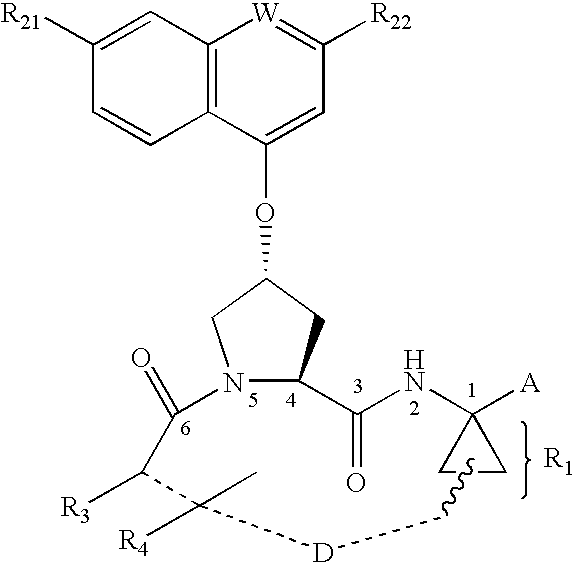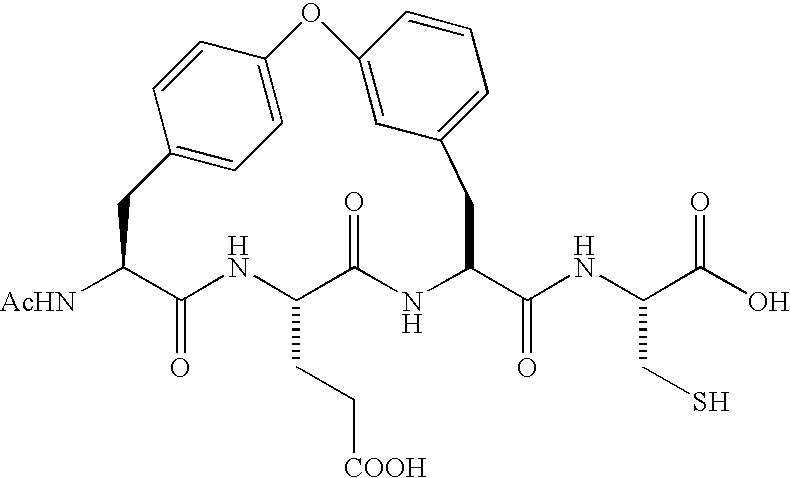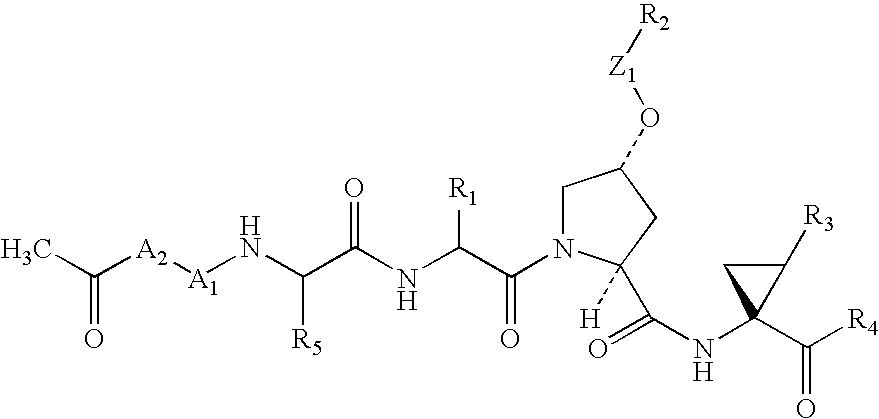Compounds as inhibitors of hepatitis C virus NS3 serine protease
a technology of serine protease and compound, which is applied in the field of new hepatitis c virus (“ hcv”) protease inhibitors, can solve the problems of low sustained response rate of therapies, frequent side effects, and poor treatment progress of patients with hcv infection
- Summary
- Abstract
- Description
- Claims
- Application Information
AI Technical Summary
Benefits of technology
Problems solved by technology
Method used
Image
Examples
preparation of specific examples
Preparation of Example 1007
[0341]
[0342]
[0343]Commercially available compound 1007a (Aldrich Chemical Co., Milwaukee, Wis., USA) was converted to 1007b according to the literature procedure (M. E. Duggan, J. S. Imagire Synthesis 1989, 131–2) in 90% yield. LC-MS: 289 (M+H).
[0344]
[0345]Deprotection of 1007b using 4M HCl in dioxane at room temperature for 3 hrs provided 1007c in quantitative yield. This material was used without further purification.
[0346]
[0347]Compound 1007d was obtained from appropriate starting materials / reagents using the previously described procedures (See preparation of Intermediate 20.08).
[0348]To a solution of 1007d (200 mg, 0.394 mmol) in dichloromethane (10 mL) at 0° C., under nitrogen atmosphere, was added 1007c (115 mg, 0.512 mmol) followed by DIPEA (0.22 mL, 1.182 mmol). The reaction was maintained at that temperature for 30 min and stored in the freezer (−20° C.) for 48 hrs. The reaction mixture was quenched with saturated ammonium chloride solution and t...
preparation of example 1044
[0355]
[0356]
[0357]Coupling reaction of the acid 1044a, obtained in a similar manner as described for 1007f (see preparation of Example 1007), with the amine salt 14.01 was carried out as described before (see preparation of Example 1007, Step 5). The crude material obtained after workup, 1044b was carried forward without purification. LC-MS: 725.2 (M+H).
[0358]
[0359]To a solution of the material from above, 1044b (0.054 mmol) in dichloromethane (5 mL) was added Dess-Martin's periodinane (68 mg, 0.16 mmol). The reaction mixture was stirred at room temperature, under nitrogen atmosphere, for 4.5 hrs. The reaction mixture was diluted with dichloromethane (10 mL) and washed with aqueous 10% Na2S2O3 (30 mL), saturated NaHCO3 (30 mL), brine (30 mL), dried (Na2SO4), filtered and concentrated in vacuo. The crude residue was purified by flash column chromatography using 35 / 65 acetone / hexanes to provide the required target compound 1044 (23 mg, 0.032 mmol, 59% yield). LC-MS: 723.2 (M+H).
[0360]...
preparation of example 1441
[0363]
[0364]
[0365]To a ice cooled solution of 1441a (4.28 g, 10.08 mmol) in anhydrous ether (100 mL) was added LAH (1.53 g, 40.32 mmol) and the reaction mixture was allowed to warm to room temperature overnight. The reaction mixture was cooled to 0° C. and EtOAc (3 mL) was added to it, followed by aqueous KHSO4 (10 g in 25 mL of H2O). The gummy residue was extracted with ether (300 mL) and the organic layer was washed with satd. NaHCO3, followed by 10% aq. KH2PO4, brine, dried over MgSO4, filtered and concentrated. The crude residue was purified by flash chromatography over SiO2 using ethyl acetate / DCM (1:4) to yield 1441b (2.14 g, 92%).
[0366]
[0367]To a ice cooled solution of 1441b (743 mg, 3.24 mmol) in anhydrous pyridine (10 mL) was added methyl chloroformate (1 mL, 13 mmol), followed by DMAP (1.6 g, 13 mmol) and the reaction mixture was allowed to warm to room temperature over 2 days. The reaction mixture was concentrated and EtOAc (100 mL) was added to it followed by 100 mL of i...
PUM
| Property | Measurement | Unit |
|---|---|---|
| temperature | aaaaa | aaaaa |
| temperature | aaaaa | aaaaa |
| pH | aaaaa | aaaaa |
Abstract
Description
Claims
Application Information
 Login to View More
Login to View More - R&D
- Intellectual Property
- Life Sciences
- Materials
- Tech Scout
- Unparalleled Data Quality
- Higher Quality Content
- 60% Fewer Hallucinations
Browse by: Latest US Patents, China's latest patents, Technical Efficacy Thesaurus, Application Domain, Technology Topic, Popular Technical Reports.
© 2025 PatSnap. All rights reserved.Legal|Privacy policy|Modern Slavery Act Transparency Statement|Sitemap|About US| Contact US: help@patsnap.com



